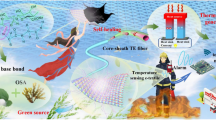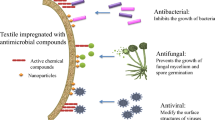Abstract
The main objective of technical protective clothing is to enhance people safety at work, which may save their life or keep them healthy away against some hazards. We developed a warning cotton fabric with a traffic safety warning photoluminescence character that continues emitting light for a long period of time after the removal of the illuminant source. Rare earth-doped strontium aluminate was dispersed in an aqueous medium of a polyacrylic-based binder to give a cross-linkable photoluminescent formula to be applied onto cotton substrate employing spray-coat approach. To introduce a transparent photoluminescent film, the Rare earth pigment must be fully dispersed to prevent aggregation. The long-persistent photoluminescent layer was deposited on cotton surface employing different concentrations of the rare earth pigment phosphor. The excitation wavelength maximum band of the spray-coated film on cotton fabric was found to occur at 365 nm, while the emission was recorded at 515 nm. Yellowish-green emissive color was monitored by CIE color data under the ultraviolet excitation source. The spray-coated fabric was characterized by wavelength dispersive X-ray fluorescence (WD-XRF), phosphorescence and excitation spectra, elements mapping, scanning electron microscopy (SEM) and energy-dispersive X-ray (EDX). The comfort measurements were studied by exploring both of fabric stiffness and air-permeability. Furthermore, the spray-coated textile substrates displayed good fastness properties and a reversible luminescent glow in the dark.




Similar content being viewed by others
References
De Rome L, Ivers R, Fitzharris M, Du W, Haworth N, Heritier S, Richardson D (2011) Motorcycle protective clothing: protection from injury or just the weather? Accid Anal Prev 43(6):1893–1900
Khattab TA, Gabr AM, Mostafa AM, Hamouda T (2019) Luminescent plant root: a step toward electricity-free natural lighting plants. J Mol Struct 1176:249–253
Ianos R, Istratie R, Păcurariu C, Lazău R (2016) Solution combustion synthesis of strontium aluminate, SrAl2O4, powders: single-fuel versus fuel-mixture approach. Phys Chem Chem Phys 18(2):1150–1157
Khattab TA, Rehan M, Hamdy Y, Shaheen TI (2018) Facile development of Photoluminescent textile fabric via spray coating of Eu (II)-Doped strontium aluminate. Ind Eng Chem Res 57(34):11483–11492
Bite I, Krieke G, Zolotarjovs A, Laganovska K, Liepina V, Smits K, Auzins K, Grigorjeva L, Millers D, Skuja L (2018) Novel method of phosphorescent strontium aluminate coating preparation on aluminum. Mater Des 160:794–802
Khattab TA, Abou-Yousef H, Kamel S (2018) Photoluminescent spray-coated paper sheet: write-in-the-dark. Carbohydr Polym 200:154–161
Sahu IP, Bisen DP, Brahme N, Tamrakar RK (2016) Generation of white light from dysprosium-doped strontium aluminate phosphor by a solid-state reaction method. J Electron Mater 45(4):2222–2232
Yan B, Lin L, Wu J, Lei F (2011) Photoluminescence of rare earth phosphors Na 0.5 Gd 0.5 WO 4: RE 3+ and Na 0.5 Gd 0.5 (Mo 0.75 W 0.25) O 4: RE 3+(RE= Eu, Sm, Dy). J fluoresc 21(1):203–211
Khattab TA, Rehan M, Hamouda T (2018) Smart textile framework: photochromic and fluorescent cellulosic fabric printed by strontium aluminate pigment. Carbohydr Polym 195:143–152
Liu Y, Wang Q-M, Xiang Y-Q, Yan B (2006) Luminescent behavior of two novel thermo-sensitive poly (N-isopropylacrylamide) hydrogels incorporated with rare earth complexes. J fluoresc 16(5):723–726
Sahu IP, Bisen DP, Brahme N, Tamrakar RK (2016) Luminescence behavior of europium activated strontium aluminate phosphors by solid state reaction method. J Mater Sci Mater Electron 27(4):3443–3455
Akmehmet GI, Šturm S, Bocher L, Kociak M, Ambrožič B, Ow-Yang CW (2016) Structure and luminescence in long persistence Eu, Dy, and B codoped strontium aluminate phosphors: the boron effect. J Am Ceram Soc 99(6):2175–2180
Sanad MMS, Rashad MM (2016) Tuning the structural, optical, photoluminescence and dielectric properties of Eu2+−activated mixed strontium aluminate phosphors with different rare earth co-activators. J Mater Sci Mater Electron 27(9):9034–9043
Yan B, Cai X, Xiao X (2009) Photoluminescence Enhancement Effect of CeO 2 in Rare Earth Composites MM′ O 3/CeO 2 and MM′ O 3/CeO 2: Pr 3+(M= Ca, Sr; M′= Ti, Zr). J Fluoresc 19(2):221–228
Rehan M, Khattab TA, Barohum A, Gätjen L, Wilken R (2018) Development of Ag/AgX (X= Cl, I) nanoparticles toward antimicrobial, UV-protected and self-cleanable viscose fibers. Carbohydr Polym 197:227–236
Crouch IG, Arnold L, Pierlot A, Billon H (2017) Fibres, textiles and protective apparel. In The Science of Armour Materials, pp. 269–330
Horrocks AR, Anand SC, eds. Handbook of technical textiles. Elsevier (2000)
Khattab TA, Fouda MMG, Allam AA, Othman SI, Bin-Jumah M, Al-Harbi HM, Rehan M (2018) Selective colorimetric detection of Fe (III) using Metallochromic tannin-impregnated silica strips. ChemistrySelect 3(43):12065–12071
Holme I (2007) Innovative technologies for high performance textiles. Color Technol 123(2):59–73
Abdelmoez S, Abd El Azeem RA, Nada AA, Khattab TA (2016) Electrospun PDA-CA Nanofibers toward Hydrophobic Coatings. Z Anorg Allg Chem 642(3):219–221
Kumar RS (2016) Textiles for industrial applications. CRC Press
Khattab TA, Aly SA, Klapötke TA (2018) Naked-eye facile colorimetric detection of alkylphenols using Fe (III)-impregnated silica-based strips. Chem Pap 72(6):1553–1559
Serbezeanu D, Popa AM, Stelzig T, Sava I, Rossi RM, Fortunato G (2015) Preparation and characterization of thermally stable polyimide membranes by electrospinning for protective clothing applications. Text Res J 85(17):1763–1775
Saini A, Christenson CW, Khattab TA, Wang R, Twieg RJ, Singer KD (2017) Threshold response using modulated continuous wave illumination for multilayer 3D optical data storage. J Appl Phys 121(4):043101
Hurwitz M (2001) Safety and sports equipment, apparel and accessories using electroluminescent fibers for illumination. U.S. Patent Application 09/728,083
Khattab TA (2018) Novel solvatochromic and halochromic sulfahydrazone molecular switch. J Mol Struct 1169:96–102
Khattab TA, Gaffer HE, Aly SA, Klapötke TM (2016) Synthesis, Solvatochromism, antibacterial activity and dyeing performance of Tricyanofuran-Hydrazone analogues. ChemistrySelect 1(21):6805–6809
Golle J, Golle A (2004) Safety vest and other clothing articles. U.S. Patent 6,769,138
Holce ME (2000) Universal mount for EL lights, retroreflective sheeting materials, and reflectors. U.S. Patent 6,086,213
Abou-Yousef H, Khattab TA, Youssef YA, Al-Balakocy N, Kamel S (2017) Novel cellulose-based halochromic test strips for naked-eye detection of alkaline vapors and analytes. Talanta 170:137–145
Khattab TA, Rehan M, Aly SA, Hamouda T, Haggag KM, Klapötke TM (2017) Fabrication of PAN-TCF-hydrazone nanofibers by solution blowing spinning technique: Naked-eye colorimetric sensor. J Environ Chem Eng 5(3):2515–2523
Horrocks AR (2016) Technical textiles in transport (land, sea, and air). In Handbook of Technical Textiles (Second Edition), pp. 325–356
Barnes FP, Barnes FP (1993) Illuminated protective clothing. US Patent 5,249,106
Zhao J, Wang X, Liu L, Yu J, Ding B (2018) Human Skin-Like, Robust Waterproof, and Highly Breathable Fibrous Membranes with Short Perfluorobutyl Chains for Eco-Friendly Protective Textiles. ACS Appl Mater Interfaces 10(36):30887–30894
Khattab TA, Haggag KM, Elnagdi MH, Abdelrahman AA, Aly SA (2016) Microwave-assisted synthesis of arylazoaminopyrazoles as disperse dyes for textile printing. Z Anorg Allg Chem 642(13):766–772
Khattab TA, Elnagdi MH, Haggaga KM, Abdelrahmana AA, Aly SA (2017) Green synthesis, printing performance, and antibacterial activity of disperse dyes incorporating arylazopyrazolopyrimidines. AATCC J Res 4(4):1–8
Khattab T, Haggag KM (2017) Synthesis and spectral properties of symmetrical and asymmetrical 3-cyano-1, 5-diarylformazan dyestuffs for dyeing polyester fabrics. Egypt J Chem 60:33–40
Fei B (2018) High-performance fibers for textiles. In Engineering of High-Performance Textiles, pp. 27–58
Chien T-L, Wu P-H (1996) Soft light-strip. U.S. Patent 5,570,945
Klein A (2000) Night visibility enhanced clothing and dog leash. U.S. Patent 6,085,698
Gaffer H, Khattab T (2017) Synthesis and characterization of some azo-heterocycles incorporating pyrazolopyridine moiety as disperse dyes. Egypt J Chem 60:41–47
Khattab TA (2018) Synthesis and Self-assembly of Novel s-Tetrazine-based Gelator. Helvetica Chimica Acta 101(4):e1800009
Habibi M, Eslamian M, Soltani-Kordshuli F, Zabihi F (2016) Controlled wetting/dewetting through substrate vibration-assisted spray coating (SVASC). J Coat Technol Res 13(2):211–225
Zabihi F, Ahmadian-Yazdi M-R, Eslamian M (2016) Fundamental study on the fabrication of inverted planar perovskite solar cells using two-step sequential substrate vibration-assisted spray coating (2S-SVASC). Nanoscale Res Lett 11(1):71
Bu Q, Zhan Y, He F, Lavorgna M, Xia H (2016) Stretchable conductive films based on carbon nanomaterials prepared by spray coating. J Appl Polym Sci 133(15):43243
Kalsi SS, Sidhu TS, Singh H, Karthikeyan J (2016) Behavior of cold spray coating in real incineration environment. Mater Manuf Process 31(11):1468–1475
Zabihi F, Eslamian M (2015) Characteristics of thin films fabricated by spray coating on rough and permeable paper substrates. J Coat Technol Res 12(3):489–503
Cohen RE, Rubner MF, Chen D, Polak R, Song K, Askar K (2018) Spray-coating method with particle alignment control. U.S. Patent Application 15/635,159
Li Y, Arumugam S, Krishnan C, Charlton MDB, Beeby SP (2019) Encapsulated textile organic solar cells fabricated by spray coating. ChemistrySelect 4(1):407–412
Liu F, Lin Z, Jin Q, Wu Q, Yang C, Chen H-J, Cao Z et al (2019) Protection of nano-structures-integrated microneedle biosensor using dissolvable polymer coating. Acs Appl Mater Interfaces. https://doi.org/10.1021/acsami.8b18981
Zabihi F, Eslamian M (2017) Low-cost transparent graphene electrodes made by ultrasonic substrate vibration-assisted spray coating (SVASC) for thin film devices. Graphene Technol 2(1–2):1–11
Gazulla MF, Rodrigo M, Vicente S, Orduña M (2010) Methodology for the determination of minor and trace elements in petroleum cokes by wavelength-dispersive X-ray fluorescence (WD-XRF). X-Ray Spectrom 39(5):321–327
d’Alfonso AJ, Freitag B, Klenov D, Allen LJ (2010) Atomic-resolution chemical mapping using energy-dispersive x-ray spectroscopy. Phys Rev B 81(10):100101
Herzing AA, Watanabe M, Edwards JK, Conte M, Tang Z-R, Hutchings GJ, Kiely CJ (2008) Energy dispersive X-ray spectroscopy of bimetallic nanoparticles in an aberration corrected scanning transmission electron microscope. Faraday Discuss 138:337–351
Spurgeon SR, Du Y, Chambers SA (2017) Measurement error in atomic-scale scanning transmission electron microscopy-nergy-dispersive X-ray spectroscopy (STEM-EDS) mapping of a model oxide interface. MicroscMicroanal 23(3):513–517
Ren X, Zhang D, Tong L, Chen X, Ding H, Yang H (2014) The effects of Gd3+ doping on the ferromagnetic and photoluminescence properties of co (Fe, Gd) 2O4@ SiO2@(Y, Gd) 2O3: Eu3+ composites. Dyes Pigments 111:91–98
Wang Y, Wu W, Fu X, Liu M, Cao J, Shao C, Chen S (2017) Metastable scheelite CdWO4: Eu3+ nanophosphors: Solvothermal synthesis, phase transitions and their polymorph-dependent luminescence properties. Dyes Pigments 147:283–290
Van den Eeckhout K, Smet PF, Poelman D (2010) Persistent luminescence in Eu2+−doped compounds: a review. Materials 3(4):2536–2566
Lakowicz JR, Cherek H, Kuśba J, Gryczynski I, Johnson ML (1993) Review of fluorescence anisotropy decay analysis by frequency-domain fluorescence spectroscopy. J Fluoresc 3(2):103–116
Zu F, Yan F, Bai Z, Xu J, Wang Y, Huang Y, Zhou X (2017) The quenching of the fluorescence of carbon dots: a review on mechanisms and applications. Microchim Acta 184(7):1899–1914
Baryshnikov G, Minaev B, Agren H (2017) Theory and calculation of the phosphorescence phenomenon. Chem Rev 117(9):6500–6537
Tiwari RS, Ludescher RD (2010) Vanillin phosphorescence as a probe of molecular mobility in amorphous sucrose. J Fluoresc 20(1):125–133
Acknowledgements
Technical support from National Research Centre, Cairo, Egypt; is gratefully acknowledged. This work was funded by the Deanship of Scientific Research at Princess Nourah bint Abdulrahman University through the Research Groups Program Grant no. (RGP-1440-0002).
Author information
Authors and Affiliations
Corresponding author
Ethics declarations
Competing Interests
The authors declare that there is no conflict of interest.
Additional information
Publisher’s Note
Springer Nature remains neutral with regard to jurisdictional claims in published maps and institutional affiliations.
Rights and permissions
About this article
Cite this article
Khattab, T.A., Fouda, M.M.G., Abdelrahman, M.S. et al. Development of Illuminant Glow-in-the-Dark Cotton Fabric Coated by Luminescent Composite with Antimicrobial Activity and Ultraviolet Protection. J Fluoresc 29, 703–710 (2019). https://doi.org/10.1007/s10895-019-02384-2
Received:
Accepted:
Published:
Issue Date:
DOI: https://doi.org/10.1007/s10895-019-02384-2




